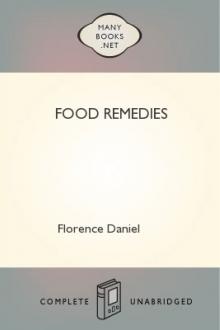The Healthy Life Cook Book, 2d ed. by Florence Daniel (read any book txt) 📕

First put on the chestnuts (without shelling or pricking) in cold water,and boil for an hour. Then remove shells and put the nuts in an enamelledsaucepan with the fat. Fry for 10 minutes. Add the flour gradually,stirring all the time, then add the water. Cook gently for half an hour.Lastly, add the parsley, boil up, and serve.
It is rather nicer if the flour is omitted, the necessary thickness beingobtained by rubbing the soup through a sieve before adding the parsley.Those who do not object to milk may use 1 pint milk and 1 pint water inplace of the 1-1/2 pints water.
5. FRUIT SOUP.
Fruit soups are used extensively abroad, although not much heard of inEngland. But they might be taken at breakfast with advantage by thosevegetarians who have given up the use of tea, coffee and cocoa, and objectto, or dislike, milk. The recipe given here is for apple soup, but pears,plu
Read free book «The Healthy Life Cook Book, 2d ed. by Florence Daniel (read any book txt) 📕» - read online or download for free at americanlibrarybooks.com
- Author: Florence Daniel
- Performer: -
Read book online «The Healthy Life Cook Book, 2d ed. by Florence Daniel (read any book txt) 📕». Author - Florence Daniel
Put on a tin in a warm oven, bake until a very pale golden colour. On no account brown. Serve with vegetable stew.
20. RICE, BOILED.1 cup unpolished rice, 3 cups water.
Put the rice on in cold water, and bring it gradually to the boil. Boil hard for 5 minutes, stirring once or twice. Draw it to the side of the stove, where it is comparatively cool, or, if a gas stove is used, put the saucepan on an asbestos mat and turn the gas as low as possible. The water should now gradually steam away, leaving the rice dry and well cooked. Serve plain or with curry.
21. RICE, SAVOURY.Cook rice as in foregoing recipe. Fry a small, finely-chopped onion in very little fat. Add this to the cooked rice with butter the size of a walnut, and a pinch of savoury herbs. Shake over the fire until hot. Serve with peeled baked potatoes and baked tomatoes.
22. RICE AND EGG FRITTERS.Mix any quantity of cold boiled rice with some chopped parsley and well-beaten egg. Beat the mixture well, form into small fritters, roll in egg and bread-crumbs or white flour, and fry to a golden brown. Serve with egg sauce.
23. TOAD-IN-THE-HOLE.Grease a pie-dish. Put in it 2 or 3 small firm tomatoes, or some small peeled mushrooms. Make a batter as for Yorkshire pudding and pour over. Bake until golden brown.
24. VEGETABLE MARROW, STUFFED.1 medium marrow, 2 ozs. butter or 1-1/2 oz. nutter, 1 dessertspoon sage, 2 medium onions, 4 tablespoons bread-crumbs, 1 tablespoon milk or water.
Chop the onion small and mix with the bread-crumbs, sage, and milk or water. Peel the marrow and scoop out the pith and pips. (Cut it in halves to do this, or, better still, if possible cut off one end and scoop out inside with a long knife.) Tie the two halves together with clean string. Stuff the marrow and bake for 40 minutes on a well-greased tin. Lay some of the nutter on top and baste frequently until done. It should brown well. Serve with brown gravy or white sauce.
25. VEGETABLE MARROW AND NUT ROAST.Make a paste as for nut roast (see recipe). Peel marrow, scoop out the inside, and stuff. Bake from 40 minutes to an hour in a hot oven. Baste frequently.
26. VEGETARIAN IRISH STEW.1 lb. tomatoes, 7 small Spanish onions, 8 medium potatoes, 1 oz. nutter or butter, 2 small carrots or parsnips, or 1 cup fresh green peas.
A saucepan with a close-fitting lid, and, if a gas stove is used, an asbestos mat (price 3-1/2d. at any ironmongers) is needed for this stew. Skin the tomatoes, peel and quarter the onions, and put them into the saucepan with the nutter and shut down the lid tightly. If a gas or oil flame is used, turn it as low as possible. Put the asbestos mat over this and stand the saucepan upon it. At the end of 1 hour the onions should be gently stewing in a sea of juice. Add the potatoes now (peeled and cut in halves). Also the peas, if in season. Cook for another hour. If carrot or parsnip is the extra vegetable used, cut into quarters and put in with the onions. When done, the onions are quite soft, and the potatoes, etc., just as if they had been cooked in a steamer.
Note that the onions and tomatoes must be actually stewing when the potatoes are put in, as the latter cook in the steam arising from the former. Consequently, they should be laid on top of the onions, etc., not mixed with them. If cooked on the kitchen range, a little longer time may be needed, according to the state of the fire. Never try to cook quickly, or the juice will dry up and burn. The slow heat is the most important point.
27. VEGETABLE PIE.Cook the vegetables according to recipe for vegetable stew. When cold put in a pie-dish (gravy and all) and cover with short crust. Bake for half an hour. If preferred, the vegetables may be covered with cold mashed potatoes in place of pie-crust. Top with a few small pieces of nutter, and bake until brown.
28. VEGETABLE STEW.1 carrot, 1 turnip, 1 potato, 1 parsnip, 2 Jerusalem artichokes, 2 onions, 2 tomatoes, 1 teaspoon lemon juice, nutter size of small walnut.
Scrub and scrape the carrot, turnip, parsnip and artichokes. Peel the potato and onions. Shred the onions and put them into a stew-pan with the nutter. Shake over the fire, and fry until brown, but do not burn or the flavour of the stew will be completely spoilt. Cut the carrot and parsnip and potato into quarters, the artichokes into halves, and put into the stew-pan with the onions. Barely cover with water. Bring to the boil and stew very gently until tender. Skin the tomatoes, break in halves, and cook slowly to a pulp in a separate pan. Add these, with the lemon juice, to the stew, and slightly thicken with a little wholemeal flour just before serving.
IV.—CASSEROLE COOKERY.Casserole is the French word for stew-pan. But "Casserole Cookery" is a phrase used to denote cookery in earthenware pots. It commends itself especially to food-reformers, as the slow cookery renders the food more digestible, and the earthenware pots are easier to keep clean than the ordinary saucepan. The food is served up in the pot in which it is cooked, this being simply placed on a dish. A large pudding-basin covered with a plate may be used in default of anything better. A clean white serviette is generally pinned round this before it comes to table. Various attractive-looking brown crocks are sold for the purpose. But anyone who possesses the old-fashioned "beef-tea" jar needs nothing else. It is important to ensure that a new casserole does not crack the first time of using. To do this put the casserole into a large, clean saucepan, or pail, full of clean cold water. Put over a fire or gas ring, and bring slowly to the boil. Boil for 10 minutes and then stand aside to cool. Do not take the casserole out until the water is cold.
1. FRENCH SOUP.2 carrots, 1 turnip, 1 leek, 1 stick celery, 1/2 cabbage, 1 bay leaf, 2 cloves, 6 peppercorns, 3 qts. water.
Scrape and cut up carrots and turnip. Slice the leek, and cut celery into dice. Shred the cabbage. Put into the jar with the water, and place in a moderate oven, or on the top of a closed range. If it is necessary to use a gas ring, turn very low and stand jar on an asbestos mat. Bring to the boil slowly and then simmer for 2-1/2 hours.
2. HOT POT.1 lb. potatoes, 2 carrots, 1 large onion, 1 turnip, 1/4 lb. mushrooms or 1/2 lb. tomatoes, 1 pint stock or water.
Wash, peel, and slice thickly the potatoes. Wash and scrape and slice the carrots and turnip. Skin the tomatoes or mushrooms. Put in the jar in alternate layers. Moisten with the stock or water. Cook as directed in recipe 1 for 1-1/2 hours after it first begins to simmer.
3. STEWED APPLES.Take hard, red apples. Wash, but do not peel or core. Put in jar with cold water to reach half way up the apples. Cover closely and put in moderate oven for 2 hours after it begins to simmer. At end of 1 hour, add sugar to taste.
4. VEGETABLE STEW.1-1/2 lbs. (when prepared and cut up) of mixed seasonable vegetables, including, whenever possible, tomatoes, celery and spinach; one tablespoonful of water.
Cut up the moist, juicy vegetables such as celery, spinach, onions and tomatoes, place them with the water in a casserole, put lid on and slowly cook for about one hour until enough juice is extracted to safely add the rest of the cut-up vegetables. The whole should now be placed in a slightly greater heat and simmered until the last added vegetables are quite tender. The mixture should be stirred occasionally with a wooden spoon.
V.—CURRIES.I do not recommend the use of curries. Many food-reformers eschew them altogether. But they are sometimes useful for the entertainment of meat-eating friends, or to tide over the attack of meat-craving which sometimes besets the vegetarian beginner. Of course there are curries and curries. Cheap curry powders are very much hotter than those of a better quality. When buying curry powder it is best to go to a high-class grocer and get the smallest possible tin of the best he keeps. It will last for years. Those who prefer to make their own curry powder may try Dr. Kitchener's recipe as follows:—
1. CURRY POWDER.3 ozs. coriander seed, 2-1/2 ozs. tumeric, 1 oz. black pepper, 1/2 oz. lesser cardamoms, 1/4 oz. cinnamon, 1/4 oz. cumin seed.
Put the ingredients into a cool oven and let them remain there all night. Next day pound them thoroughly in a marble mortar, and rub through a sieve. Put the powder into a well-corked bottle.
A spice machine may be used instead of the mortar, but in that case the tumeric should be obtained ready powdered, as it is so hard that it is apt to break the machine. The various ingredients are generally only to be obtained from a large wholesale druggist.
2. EGG CURRY.1 large onion, 1 dessertspoon curry powder, 1 oz. butter or nutter, 3 hard-boiled eggs, 1 dessertspoon tomato pulp, 1 teacup water.
Shred the onion, put it in the stew-pan with the butter, sprinkle the curry powder over, and fry gently until quite brown. Shell the eggs and cut them in halves. Add the eggs, the tomato pulp, and the water. Stir well, and simmer until the liquid is reduced to one-half. This will take about 15 minutes. Serve with plain boiled unpolished rice.
3. GERMAN LENTIL CURRY.Use the ingredients given, and proceed exactly the same as for egg curry. But in place of eggs, take 1 breakfastcup of cold cooked German lentils (see recipe for cooking lentils). Use also 2 teacups water in place of the 1, and only 3/4 oz. butter or nutter.
4. VEGETABLE CURRY.Use the ingredients given and proceed the same as for German lentil curry, using any cold steamed vegetables in season. The best curry, according to an Indian authority, is one made of potatoes, artichokes, carrots, pumpkin and tomatoes.
Note.—A writer in Cassell's Dictionary of Cookery says:—"A spoonful of cocoanut kernel dried and powdered gives a delicious flavour to a curry, as does also acid apple."
VI.—VEGETABLES.Never eat boiled vegetables. No one ever hears of a flesh-eater boiling his staple article of diet and throwing away the liquor. On the contrary, when he does indulge in boiled meat, the liquor is regarded as a valuable asset, and is used as a basis for soup. But his meat is generally conservatively cooked—that is, it is baked, roasted, or grilled, so that the juices are retained. If he has to choose between throwing away the meat or the water in which it has been boiled, he keeps the liquor—witness "beef-tea." For some unknown reason he does not often treat his vegetables in the same way, and suffers thereby the loss of much valuable food material.
The vegetarian—being avowedly a thinker and a pioneer—would, it might be imagined, treat what is now one of his staple articles of diet at least as carefully as the out-of-date flesh-eater. But no! For the most part, his vegetables are boiled, and when the best part of the food constituents and all the flavour have been extracted, he dines off a mass of indigestible fibre—mere waste matter—and allows the "broth" to be thrown down the sink, with the consequence that many vegetarians are pale, flabby individuals who succumb to the slightest strain, and suffer from chronic dyspepsia.
The remedy is simple. Treat vegetables as you used to treat meat. Bake or stew them in their own juice. (See recipe for Vegetarian Irish Stew.) At the least, steam them. A little of the valuable vegetable salts are lost in the steaming, but not much. Better still, use a double boilerette. A very little water is put into the inner pan and soon becomes steam, so that by the time the vegetable is cooked it has all disappeared.





Comments (0)